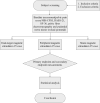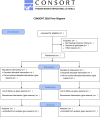Dual-target peripheral and central magnetic stimulation for rehabilitation of chronic pelvic pain syndrome associated with psychosomatic symptoms: Study protocol for a randomized controlled trial
- PMID: 40674346
- PMCID: PMC12270166
- DOI: 10.1371/journal.pone.0326740
Dual-target peripheral and central magnetic stimulation for rehabilitation of chronic pelvic pain syndrome associated with psychosomatic symptoms: Study protocol for a randomized controlled trial
Abstract
Introduction: Chronic pelvic pain syndrome (CPPS) is frequently associated with psychological issues. Repetitive peripheral magnetic stimulation (rPMS) is potentially effective in treating CPPS, while repetitive transcranial magnetic stimulation (rTMS) has demonstrated therapeutic effects on anxiety and depression. Therefore, the study proposed herein aims to assess the efficacy and safety of dual-target magnetic stimulation in CPPS patients with psychological disorders.
Methods: This prospective, double-blind, randomized controlled trial will recruit 75 CPPS participants. After stratification by sex, participants will be randomly assigned via block randomization (1:1:1), sequentially based on enrollment order, to one of three groups: dual-target magnetic stimulation (rPMS and rTMS), rPMS, and sham stimulation, all receiving standard treatment. The dual-site magnetic stimulation group will receive left dorsolateral prefrontal cortex (DLPFC) rTMS (120% resting motor threshold [RMT], 10 Hz, 4-s stimulation, 26-s interval, 3000 pulses in total [depression cases]) or right DLPFC rTMS (120% RMT, 1 Hz, 10-s stimulation, 2-s interval, 1000 pulses in total [anxiety cases]) combined with rPMS (50% of maximum stimulation intensity, 20 Hz, 2-s stimulation, 28-s interval, 1600 pulses in total). The rPMS group will receive only rPMS. The sham stimulation group will undergo sham transcranial and peripheral stimulation. All treatments will be administered five times a week, once daily, for 4 weeks. Primary outcomes will be the pelvic pain scale (females) or the National Institutes of Health Chronic Prostatitis Symptom Index (NIH-CPSI, males). Secondary outcomes will include assessment of pelvic floor muscle surface electromyography, pudendal nerve motor evoked potentials, the Depression, Anxiety, and Stress Scale (DASS-21), and the Short Form 36 (SF-36) quality of life scale.
Discussion: We hypothesize that dual-target magnetic stimulation will show greater effectiveness than rPMS and sham stimulation in relieving pain symptoms and psychological distress in CPPS patients with comorbid mental disorders.
Clinical trial registration: The study was prospectively registered at the Chinese Clinical Trial Registry (ChiCTR; http://www.chictr.org.cn, ID: ChiCTR2300078761) on December 18, 2023; Protocol version 1.0-20220709.
Copyright: © 2025 Luo et al. This is an open access article distributed under the terms of the Creative Commons Attribution License, which permits unrestricted use, distribution, and reproduction in any medium, provided the original author and source are credited.
Conflict of interest statement
The authors have declared that no competing interests exist.
Figures
Similar articles
-
Non-pharmacological interventions for treating chronic prostatitis/chronic pelvic pain syndrome.Cochrane Database Syst Rev. 2018 May 12;5(5):CD012551. doi: 10.1002/14651858.CD012551.pub3. Cochrane Database Syst Rev. 2018. PMID: 29757454 Free PMC article.
-
Comparison of 5-Day Multidaily Neuronavigated Theta-Burst Sessions With 6-Week Standard Repetitive Transcranial Magnetic Stimulation (the Dutch Depression Outcome Trial): Protocol for a Randomized Controlled Trial.JMIR Res Protoc. 2025 Aug 21;14:e70121. doi: 10.2196/70121. JMIR Res Protoc. 2025. PMID: 40840870
-
Non-invasive brain stimulation techniques for chronic pain.Cochrane Database Syst Rev. 2018 Mar 16;3(3):CD008208. doi: 10.1002/14651858.CD008208.pub4. Cochrane Database Syst Rev. 2018. Update in: Cochrane Database Syst Rev. 2018 Apr 13;4:CD008208. doi: 10.1002/14651858.CD008208.pub5. PMID: 29547226 Free PMC article. Updated.
-
Non-invasive brain stimulation techniques for chronic pain.Cochrane Database Syst Rev. 2018 Apr 13;4(4):CD008208. doi: 10.1002/14651858.CD008208.pub5. Cochrane Database Syst Rev. 2018. PMID: 29652088 Free PMC article.
-
Non-pharmacological interventions for treating chronic prostatitis/chronic pelvic pain syndrome.Cochrane Database Syst Rev. 2018 Jan 26;1(1):CD012551. doi: 10.1002/14651858.CD012551.pub2. Cochrane Database Syst Rev. 2018. Update in: Cochrane Database Syst Rev. 2018 May 12;5:CD012551. doi: 10.1002/14651858.CD012551.pub3. PMID: 29372565 Free PMC article. Updated.
References
Publication types
MeSH terms
LinkOut - more resources
Full Text Sources
Medical




